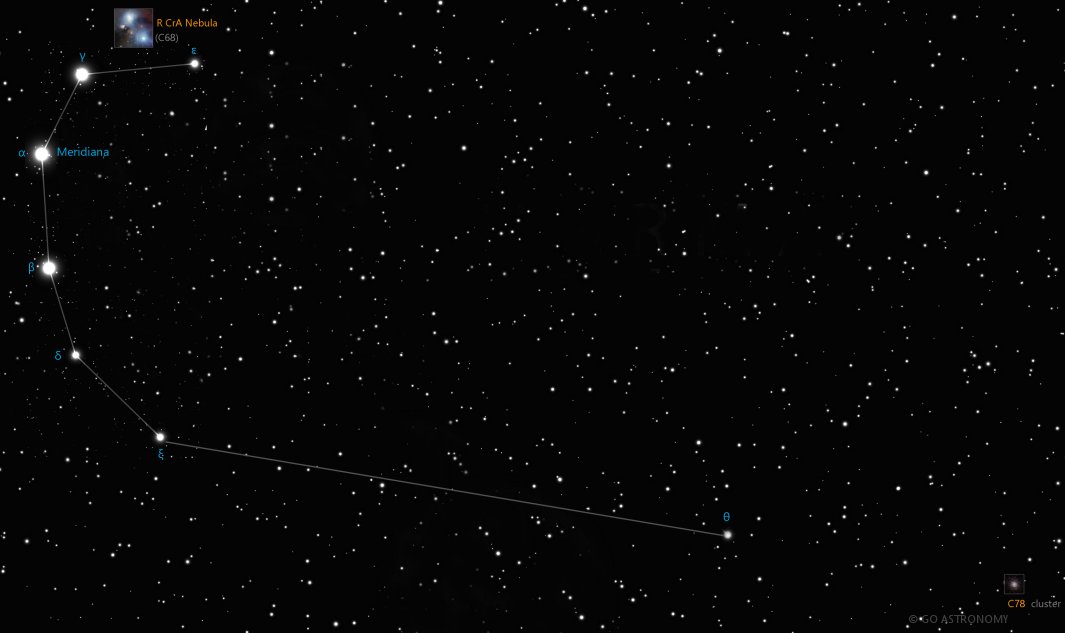Corona Australis, the Southern Crown (CrA)
(cuh-ROW-nuh aw-STRAL-iss)
The Southern constellation of Corona Australis, the Southern Crown, is best viewed in Summer during the month of August.
Corona Australis is the 80th largest constellation. It's brightest star is Meridiana at magnitude 4.10. The boundary of the Corona Australis constellation contains 1 stars that host known exoplanets.
- Pronunciation:
- cuh-ROW-nuh aw-STRAL-iss
- Meaning:
- Southern Crown
- Genitive:
- Coronae Australis
- Abbreviation:
- CrA
- Constellation Family:
- Hercules
- Hemisphere:
- Southern
- Quadrant:
- SQ4
- Visibility:
- 40° N - 90° S
- Best viewing month*:
- August
- Area:
- 128 sq. degrees
- Size:
- 80th largest
- Right Ascension (avg):
- 18h 39m
- Declination (avg):
- -40°
- Brightest star:
- Meridiana (4.10)
- Stars with planets:
- 1
- X-ray stars:
- 2 (binary) stars
- Messier objects:
- |
Brightest Stars in Corona Australis
The 10 brightest stars in the constellation Corona Australis by magnitude.
- Star
- Magnitude
- Spectral class
- Beta Coronae Australis (β CrA)
- 4.1
- K0II/IIICN
- Alpha Coronae Australis (α CrA)
- 4.11
- A0/A1V
- Gamma Coronae Australis (γ CrA)
- 4.23
- F7IV-V
- Delta Coronae Australis (δ CrA)
- 4.57
- K1III
- Theta Coronae Australis (θ CrA)
- 4.62
- G5III
- Zeta Coronae Australis (ζ CrA)
- 4.74
- A0Vn
- Epsilon Coronae Australis (ε CrA)
- 4.83
- F3IV/V
- HD 165189
- 4.92
- A5V
- Gamma Coronae Australis (γ CrA)
- 4.99
- HD 168592
- 5.09
- K4/K5III
Star Clusters in Corona Australis
The most notable and easy-to-find star clusters in the constellation Corona Australis . Also see all star clusters.
Nebulae in Corona Australis
Notable and easy-to-find nebulae in the constellation Corona Australis. Also see all nebulae.
- Nebula name
- Catalog #
- Nebula type
- Corona Australis Nebula
- C68
- reflection
- Corona Australis Cloud
- molecular cloud
The Southern Celestial Crown
Corona Australis, which translates to "The Southern Crown," is a small constellation in the Southern Hemisphere. It's renowned for its semi-circular pattern of stars, reminiscent of a crown, and hosts a wealth of astronomical objects of interest.
Historical Overview
The constellation has been known by various cultures across history, with each attaching its unique lore to the pattern of stars. In ancient Greece, it was associated with the crown that Bacchus, the god of wine, wore. Some native Australian groups saw it as a boomerang, a common tool and weapon in their culture. Its portrayal as a crown has persisted, and today it is commonly referred to as the Southern Crown.
Location and Notable Features
Corona Australis is located at celestial coordinates of approximately 19h 00m 00s (right ascension) and -40? 00' 00" (declination). This constellation lies adjacent to the constellations of Sagittarius and Scorpius, and it is best seen at latitudes between +40? and -90?.
Despite its small size, Corona Australis contains a number of interesting stars. Its brightest star, Alpha Coronae Australis or Meridiana, is a class G yellow-white giant with an apparent magnitude of 4.10. Other prominent stars in this constellation include Beta, Gamma, Delta, and Epsilon Coronae Australis, which together with Alpha form the distinctive crown shape.
Deep Sky Objects
While it may lack bright stars, Corona Australis makes up for this with its plethora of deep-sky objects. The Corona Australis molecular cloud, one of the nearest star-forming regions to our Solar System, is a massive dust and gas cloud where new stars are being born. This active star-forming region is home to the variable star R Coronae Australis and several Herbig-Haro objects, which are bright patches of nebulosity associated with newborn stars.
The constellation also contains two notable globular clusters: NGC 6541 and NGC 6723. These spherical collections of stars are amongst the oldest inhabitants of the universe, offering astronomers insight into the early universe and stellar evolution.
Observing Corona Australis
Due to its southern declination, Corona Australis is best observed from the southern hemisphere, but can also be seen from much of the northern hemisphere during the summer months. Its highest point in the sky, or culmination, during the middle of July makes it a feature of the winter sky in the southern hemisphere and the summer sky in the north.
Although it is not a particularly bright constellation, the distinct pattern of stars forming a crown or arc makes it easier to identify. Look for it near the much brighter constellations of Sagittarius and Scorpius.
With a small telescope or good binoculars, deep-sky objects such as the globular clusters NGC 6541 and NGC 6723 and parts of the Corona Australis molecular cloud can be observed.
* Constellation shown for northen hemisphere skies. For the southern hemisphere, constellations appear rotated 180 degrees (upside-down and left-right reversed) from what is shown. Remember that seasons are reversed too - summer in northern latitudes is winter in southern latitudes.
** Circumpolar constellations are visible year-round in the hemisphere listed (and not at all in the opposite hemisphere).





